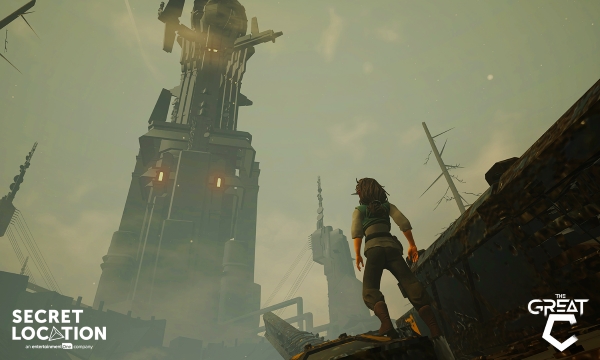[The creators of a new Cinematic VR film are testing the limits and learning best production practices for transitioning the VR medium from short-form demos and games to long-form engaging narratives. This story is from Variety, where the original includes more images. –Matthew]

Venice: Secret Location’s ‘The Great C’ Takes an Ambitious Stab at Long-Form VR
By Janko Roettgers
August 28, 2018
When the Venice Film Festival opens its doors this week, audiences will once again get to see a number of virtual reality (VR) titles. And anyone who has followed VR might notice a trend: Cinematic VR, as non-gaming titles are often being called, is getting longer, with experiences slowly but surely approaching the VR equivalent of a feature film.
Case in point: “The Great C,” which is based on a Philip K. Dick short story of the same name, clocks in at just above 30 minutes, and spans 20 unique environments. Luke Van Osch, who produced the animated film for the Toronto- and Los Angeles-based VR startup Secret Location, told Variety during a recent interview that many of the existing VR experiences out there still felt like a demo for the technology itself.
The goal with “The Great C” was to create something that felt “substantial,” he said. “We wanted to make something that feels like a rich and rewarding piece on its own.”
Like Philip K. Dick’s short story, the VR adaptation of “The Great C” is set in a post-apocalyptic world, where survivors are ruled by an almighty computer that forces them to sacrifice one of the village’s young men every year. In the film, the male would-be victim is being accompanied on his journey by his fiance Clare. Together, they embark on a perilous journey that makes them question the things they know about civilizations past, and wonder whether they can escape their fate.
Van Osch’s team at Secret Location originally was looking to add more interactivity to the story, including subplots and easter eggs that viewers could find by rewatching the film, and even considered some gamified elements. “We started off with everything on the table,” recalled Van Osch. In the end, the team scrapped those ideas to keep the focus on the story. “It just totally interrupted the flow and pace of the main narrative,” he said.
As part of that process, Secret Location also built an initial version of the story that allowed viewers to switch between different virtual camera angles, and pick their own vantage points as the action unfolded. That, too, was ultimately too distracting — but the team found that it could use the same tech to work on the film while wearing a headset, and pick the camera angles used in the final version. “That turned into a development tool for us,” said Van Osch.
The resulting film is notable not only for its length, but also for the way it uses a lot of traditional filmmaking techniques, including long zooms and other forms of camera motion that you don’t typically see in VR. Most VR producers still shy away from motion for the fear of inducing nausea, which can occur as a result of the dissociation between a viewer moving in VR but not in real life.
“We’re kind of of the mind that those rules aren’t really set yet,” said Van Osch about motion in VR. For “The Great C,” Secret Location worked with a few tricks to make motion more headset-friendly.
In one scene, Clare is on a rooftop, with the camera zooming in from overhead. Only, we don’t actually get to see all the details of the rooftop right away. Instead, it slowly materializes as the camera comes closer, which both adds drama and also ensures that the audience won’t feel weak in their knees. “It was definitely a discovery process,” he said.
After premiering at the festival, “The Great C” will first make its way to location-based VR exhibitors, where it is scheduled to be shown as early as September. The film will ultimately be available on regular VR headsets in the 4th quarter, with additional details to be announced at a later date.
That staggered release could be a big experiment for VR in itself: Most VR centers have had more success with games than with cinematic VR, and non-gaming titles are typically optimized for quick throughput. Will a 30-plus-minute film work in that environment? “This is the perfect use case for us to test it out,” said Secret Location co-founder and president Ryan Andal.
Ultimately, “The Great C” may also be a test case for further long-form VR storytelling. Van Osch argued that VR films could be even longer. “I don’t think ‘The Great C’ has hit that ceiling,” he said.